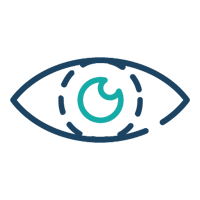Read on to find out more about color blindness, also known as color vision deficiency (CVD).
What is Color Blindness?
Color blindness occurs in 1 out of 12 men (8%) and in 1 out of 200 women (0.5%). The inability to differentiate between certain colors is referred to as color blindness or color vision deficiency. Genetics plays a major role in color blindness.
Color vision is perceived by your photoreceptors specifically cones in the back of your eye. There are two different types of photoreceptors. Photoreceptors called rods are responsible for seeing in the dark and for night vision, while cones are responsible for color vision and seeing in the daylight. A color deficiency is usually caused by an issue with cones to perceive certain wavelengths of light.
The reason why deficiency is a better term than color blindness is that most people with color blindness are not actually seeing the world as black and white, they just have a decreased ability to differentiate between certain colors, the most common one usually being red and green.
What are the Causes of Color Blindness?
In addition to being inherited, color blindness can also be acquired because of several different reasons, such as optic nerve disease or atrophy. Different medications, strokes to the eye, and toxic materials can cause color deficiencies. In cases where it is acquired over time, it can affect one eye or both, but in cases where it is inherited in a bilateral manner, both of your eyes should be equally affected.
What are the Different Types of Color Blindness?
There are several types of color deficiencies.
- Patients with deuteranomaly have difficulty seeing green colors. This is the most common type of color blindness
- Patients with protanomaly have a hard time seeing red colors.
- Tritanomaly can make it hard to distinguish between blue and green and yellow and red. Usually tritanomaly is the type of color blindness that's mostly acquired and not actually inherited genetically.
- With protanopia you cannot tell the difference between red and green
Who is at Risk?
The prevalence of color blindness among men is about 16 times higher than that among women, according to medical data. This is due to the genetic nature of color blindness. A person with a close relative affected by colorblindness is more likely to also be colorblind themselves because the condition is usually genetic.
You may be more likely to develop acquired color deficiency if you have certain conditions, such as:
How is Color Blindness Diagnosed?
Using a color textbook is the best way for us to determine if you have any color deficiencies. During your visit, your eye doctor will show you an image consisting of colored dots with a different-colored number or shape in the middle. You may be colorblind if the shape blends into the background and you are unable to distinguish it from the background. A variety of color plates can be used to test for different types of color blindness.
Usually the first page is just the test page, and everyone should be able to tell what that number is. As you move on to other pages, it becomes more challenging. The majority of patients without color deficiency do just fine.
Can color blindness be treated?
Inherited color blindness cannot be treated, but there are options that can make it easier to live with such as special contact lenses or glasses such as EnChroma lenses, and assistive software. Many computers and smartphones include color-adjusting display options to make color more accessible to color blind people. In the case of acquired forms of color blindness, your optometrist will address the underlying health problem or drug that may have caused color blindness.











